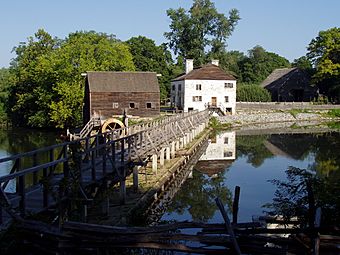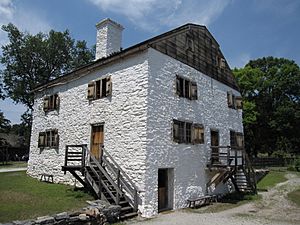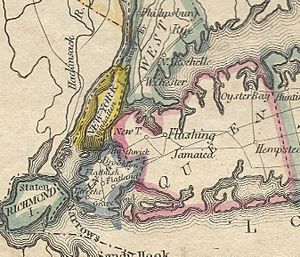Philipsburg Manor House facts for kids
|
Philipsburg Manor
|
|

The manor
|
|
| Location | Sleepy Hollow, New York |
|---|---|
| Nearest city | White Plains |
| Built | 1693 |
| NRHP reference No. | 66000584 |
Quick facts for kids Significant dates |
|
| Added to NRHP | October 15, 1966 |
| Designated NHL | November 5, 1961 |
Philipsburg Manor House is a historic house. It is located in Sleepy Hollow, New York. This house was once part of a very large estate. Today, it is a museum. It helps people learn about life in colonial America. A group called Historic Hudson Valley runs the museum.
The manor is sometimes listed with Dutch patroonships. A patroonship was a large land grant in New Netherland. This is because Philipsburg Manor included land once owned by a Dutch Jonkheer (a noble title).
Contents
History of Philipsburg Manor
The story of Philipsburg Manor began in 1693. A rich merchant named Frederick Philipse lived in the Province of New York. The British Crown gave him a special paper called a charter. This charter gave him control of about 52,000 acres of land. This land was located along the Hudson River.
Frederick Philipse built a special place where the Pocantico River met the Hudson River. This spot was used to store supplies for his family's trade across the Atlantic Ocean. It was also the main office for his shipping business. For over 30 years, Frederick, his wife Margaret, and later his son Adolph, were involved in the shipping of many African people. These individuals were brought across the Atlantic as enslaved people.
Life at the Manor
By the mid-1700s, the Philipse family owned many enslaved people. They had one of the largest groups of enslaved people in the northern colonies. The main home for the Philipse family was Philipse Manor Hall in Yonkers.
Farmers from different European backgrounds rented land from the Philipses. Enslaved Africans did much of the work at the manor. For example, in 1750, 23 enslaved men, women, and children lived and worked there.
The Manor During the American Revolution
When the American Revolutionary War started, the Philipse family supported the British. Because of this, their land was taken by the American side. Then, it was sold off.
The manor house was used during the war. British General Sir Henry Clinton used it in 1779. While there, he wrote an important paper. It is known as the Philipsburg Proclamation. This paper said that all enslaved people owned by American Patriots would be free. It also stated that Black people captured while fighting for the Patriots would be sold into slavery.
Philipsburg Manor Today
Philipsburg Manor was named a National Historic Landmark in 1961. Today, it is a working farm and museum. You can see the old stone manor house. It has furniture from the 1600s and 1700s.
There is also a grist mill that uses water power. It has a millpond. You can also see an old barn from the 1700s. There is a garden where enslaved people grew food. A tenant farm house has also been rebuilt.
People dressed in old-fashioned clothes work at the museum. They show what life was like before the American Revolution. They do chores, milk cows, and grind grain in the mill. In 2016, the grist mill was repaired. Its wooden waterwheel and flume were rebuilt. This work was supported by the New York State Council on the Arts.
See also
- List of National Historic Landmarks in New York
- National Register of Historic Places listings in northern Westchester County, New York
External links
- Historic Hudson Valley
- Clemco Construction: 2016 Historic Restoration of Philipsburg Manor Mill
nl:Philipsburg Manor



